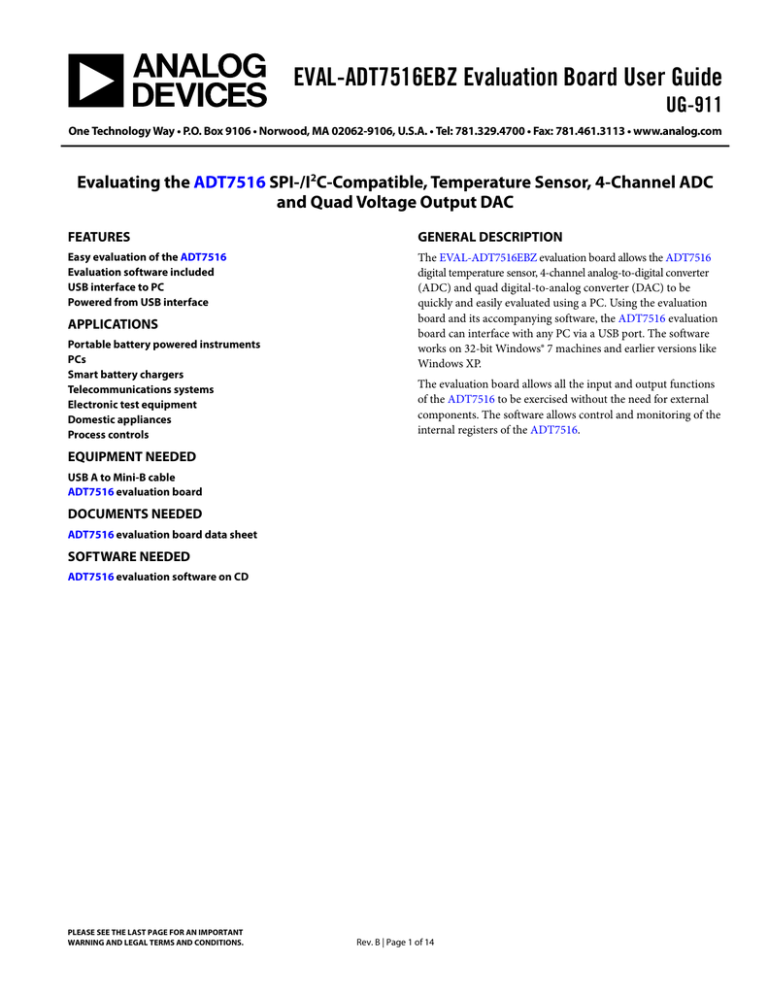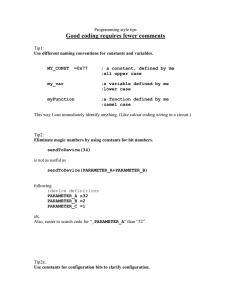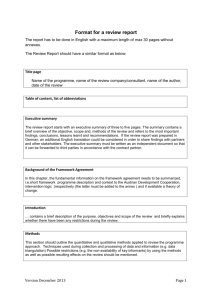EVAL-ADT7516EBZ Evaluation Board User Guide UG-911
advertisement

EVAL-ADT7516EBZ Evaluation Board User Guide UG-911 One Technology Way • P.O. Box 9106 • Norwood, MA 02062-9106, U.S.A. • Tel: 781.329.4700 • Fax: 781.461.3113 • www.analog.com Evaluating the ADT7516 SPI-/I2C-Compatible, Temperature Sensor, 4-Channel ADC and Quad Voltage Output DAC FEATURES GENERAL DESCRIPTION Easy evaluation of the ADT7516 Evaluation software included USB interface to PC Powered from USB interface The EVAL-ADT7516EBZ evaluation board allows the ADT7516 digital temperature sensor, 4-channel analog-to-digital converter (ADC) and quad digital-to-analog converter (DAC) to be quickly and easily evaluated using a PC. Using the evaluation board and its accompanying software, the ADT7516 evaluation board can interface with any PC via a USB port. The software works on 32-bit Windows® 7 machines and earlier versions like Windows XP. APPLICATIONS Portable battery powered instruments PCs Smart battery chargers Telecommunications systems Electronic test equipment Domestic appliances Process controls The evaluation board allows all the input and output functions of the ADT7516 to be exercised without the need for external components. The software allows control and monitoring of the internal registers of the ADT7516. EQUIPMENT NEEDED USB A to Mini-B cable ADT7516 evaluation board DOCUMENTS NEEDED ADT7516 evaluation board data sheet SOFTWARE NEEDED ADT7516 evaluation software on CD PLEASE SEE THE LAST PAGE FOR AN IMPORTANT WARNING AND LEGAL TERMS AND CONDITIONS. Rev. B | Page 1 of 14 UG-911 EVAL-ADT7516EBZ Evaluation Board User Guide TABLE OF CONTENTS Features .............................................................................................. 1 VREF Input Connector (P1) ........................................................3 Applications ....................................................................................... 1 AIN Analog Input Connector (P2) .............................................3 Equipment Needed ........................................................................... 1 Test Points ......................................................................................3 Documents Needed .......................................................................... 1 Evaluation Board Software Quick Start Procedures .....................4 Software Needed ............................................................................... 1 Installing the Software ..................................................................4 General Description ......................................................................... 1 Using the Software ........................................................................4 Revision History ............................................................................... 2 Evaluation Board Schematics and Artwork ...................................8 Evaluation Board Hardware ............................................................ 3 Ordering Information .................................................................... 13 Using the Hardware...................................................................... 3 Bill of Materials ........................................................................... 13 Mini-B USB Connector (J1) ....................................................... 3 DAC Output Connector (J2) ...................................................... 3 REVISION HISTORY 2/16—Rev. A to Rev. B Update Format .................................................................... Universal Deleted ADT7517 and ADT7519 ................................ Throughout Changes to General Description .................................................... 1 Changes to Evaluation Board Hardware Section ......................... 3 Changes to Evaluation Board Software Quick Start Procedures Section ................................................................................................ 4 Changes to Configuration Section ................................................. 5 Changes to Figure 19 to Figure 21 ................................................ 12 Changes to Table 2 .......................................................................... 13 2/07—Revision A: Initial Version Rev. B | Page 2 of 14 EVAL-ADT7516EBZ Evaluation Board User Guide UG-911 EVALUATION BOARD HARDWARE The ADT7516 combines a 10-bit temperature to digital converter and a quad 12-bit DAC, respectively, in a 16-lead QSOP. These devices include a band gap temperature sensor and a 10-bit ADC to monitor and digitize the temperature reading to a resolution of 0.25°C. The ADT7516 operates from a single 2.7 V to 5.5 V supply. The input voltage range on the ADC channels is 0 V to 2.28 V, and the input bandwidth is dc. The reference for the ADC channels is derived internally. The output voltage of the DAC ranges from 0 V to VDD, with an output voltage settling time of typically 7 ms. The ADT7516 provides two serial interface options, a 4-wire serial interface that is compatible with SPI, QSPI™, MICROWIRE™, and DSP interface standards and a 2-wire SMBus/I2C interface. The ADT7516 features a standby mode that is controlled via the serial interface. The EVAL-ADT7516EBZ evaluation board contains the following main components that can be identified from the printed circuit board (PCB) silkscreens and the schematic diagrams (see Figure 15 to Figure 21): • • • • • • • • • • • • • ADT7516 IC (U1) USB microcontroller (U9) Interface buffers and analog switches Power LED, green (D1) Interrupt LED, red (D2) Temperature sensor (Q1) Photodiode sensor (U14) Bar graph driver and LED bar graph (U12/U8) Connector for USB interface (J1) DAC output connector (J2) VREF input connector (P1) AIN analog input connector (P2) LDAC push-button (S1) USING THE HARDWARE The hardware is extremely simple to use. Before connecting the evaluation board to a USB port on the PC, using the USB A to Mini-B cable provided, make sure the software is installed. No external power supply is required. MINI-B USB CONNECTOR (J1) The connections to J1 are shown in Table 1. Table 1. J1 Connections J1 Pin 1 2 3 4 5 Mini-B Function 5V −Data +Data Key (not used, connected to ground) Ground The communication between the Mini-B plug and the rest of the evaluation board is handled by the USB microcontroller (U9). DAC OUTPUT CONNECTOR (J2) The output of any one of the four DACs (selected by the software) is available on this connector. VREF INPUT CONNECTOR (P1) The architecture of one DAC channel consists of a resistor string DAC followed by an output buffer amplifier. The reference voltage for the selected DAC is determined by the on-chip reference of 2.28 V or an external reference voltage, which may be connected to P1. AIN ANALOG INPUT CONNECTOR (P2) The ADT7516 offer four single-ended analog input channels, which range from 0 V to 2.28 V, or 0 V to VDD. This analog input may be connected using P1. TEST POINTS Various system logic signals and the individual DAC outputs are available at the test points on the board. Rev. B | Page 3 of 14 UG-911 EVAL-ADT7516EBZ Evaluation Board User Guide EVALUATION BOARD SOFTWARE QUICK START PROCEDURES The software allows control of the ADT7516 functions from a PC via an easy-to-use interface. The contents of the internal registers of the device can be read easily or altered through a user friendly interface, while the Visual Display dialog box gives a graphical display of the temperature and the voltage and allows the overtemperature limit to be altered using a slider control. If a Typical or Compact installation is selected, omit this step, and the Select Program Folder dialog box will appear. This box allows you to select the program folder to add the program icons to. Select the desired folder and click Next >. INSTALLING THE SOFTWARE If an existing version of the software is found during installation, you may modify the existing installation by adding or removing components, repair the installation by replacing existing files with ones from the CD (useful if a file has been corrupted), or uninstall the entire software package. To install the software, insert the supplied CD. Click Start > Run, and enter X:ADT7516Eval.exe, where X: is the letter of your CD drive, and then click OK. Alternatively, run Windows Explorer or go to My Computer, select the CD drive, and double-click the ADT7516 v2.0.2.exe icon. The installer extracts the files needed to install the software and starts the InstallShield® Wizard. InstallShield now installs the program files to the selected folders. Click Finish to complete the installation. Select the desired option and click Next >. If Modify is selected, you may add or remove components. If Repair is selected, all of the installed files are replaced with the new files from the CD. If Remove is selected, a prompt appears to confirm the complete removal of the software. Click OK to confirm removal of the software. During removal of the software, you may need to confirm removal of some files. These files may be used by other Analog Devices, Inc. software. If no other Analog Devices software is installed on the system, it is safe to delete the files. To remove all shared files without further prompting, check Don't display this message again before clicking Yes. Click Finish to complete the maintenance procedure. 04827-008 USING THE SOFTWARE Figure 1. InstallShield Wizard Startup Screen Click Next > to continue the installation. Various installation options are available, depending on whether a version of the software is already installed. A license agreement appears if this is a completely new installation. Click Yes to accept the agreement and continue with the installation. When using the software, first ensure that the evaluation board is connected to the USB port and the Power LED D1 is on. To start the software, click Start > All Programs > Analog Devices > ADT7516 Evaluation Software > ADT7516 Evaluation Software. The software searches for the evaluation board and initializes it. If you want to install the software in the default folder shown, click Next >. Otherwise, click Browse and choose a different folder. Select the folder in which to install the program and click OK. If Custom is selected, a window appears allowing individual components to be installed. Uncheck any components you do not wish to install, and click Next >. Rev. B | Page 4 of 14 04827-009 You are given the option of a Typical, Compact, or Custom installation of the software. Select the desired option and click Next >. Figure 2. EVAL-ADT7516EBZ Evaluation Software Found EVAL-ADT7516EBZ Evaluation Board User Guide UG-911 The Devices Options tab (see Figure 5) selects or enables/disables various options, such as monitoring, power down, averaging, interrupt, active low INT polarity, and SPI interface. 04827-010 If the evaluation board is not found, the message in Figure 3 appears. If this happens, check that the evaluation board is connected correctly, that D1 is lit, and then try again. Figure 3. EVAL-ADT7516EBZ Evaluation Software Not Found 04827-012 At the top of the program window is a series of drop-down menus and menu icons that can access the various functions of the software (see Figure 4), or you can use the Settings menu to select these functions. Figure 5. Device Options Tab Note that if the ADT7516 SPI interface is enabled, it is necessary to exit the software, disconnect the board, and start again to switch back to the I2C interface. INTERRUPTS AND LIMITS ICON DAC OUTPUT CONTROL ICON Pin AIN1 to Pin AIN3 are multiplexed and their operation can also be toggled here. GRAPH DISPLAY ICON CONFIGURATION ICON DATA LOG ICON 04827-011 REGISTER TREE ICON Figure 4. Menu and Icon Bar The menu icons include the following: • • • • • • The Interrupts and Limits icon sets up interrupts and limits. The DAC Output Control icon allows adjustment of the DAC outputs. The Settings menu can also select these functions. The Register Tree icon displays a tree of the device registers. The Graph Display icon displays the temperature and voltage graphs. The View menu can also select these functions. The Configuration icon allows device configuration. The Data Log icon allows data to be logged and saved. The File menu can also be used. The DAC Options tab (see Figure 6) selects the output range for each DAC (0V to VRef or 0V to 2VRef). It allows configuration of the thermal voltage function of the device, where the ADT7516 operates as a temperature to voltage converter, with DAC A controlled by the on-chip temperature sensor, and DAC B controlled by the external temperature sensor. To set the temperature corresponding to the 0 V output, adjust the analog offset for each channel. In addition, the resolution for the thermal voltage function can be set to 8 bits or 10 bits. Multiple windows for the previous software functions can be open and active simultaneously. The Window menu shows which window is on top and allows any window to come to the front. Configuration 04827-013 Click the Configuration icon or use the Device menu to access the Configuration dialog box to set up the ADT7516. It consists of a set of four tabs that allows configuration of various functions of the device. Figure 6. DAC Options Tab Rev. B | Page 5 of 14 UG-911 EVAL-ADT7516EBZ Evaluation Board User Guide 04827-016 The LDAC Options tab (see Figure 7) allows users to select how the DACs are updated. The DACs can be updated manually from the LDAC pin by pressing S1, when the MSBs are written to one of the DACs (three different options are available), or from the LDAC register. If the LDAC register is selected, the LDAC Generation buttons are active, and clicking one of the buttons updates the corresponding DAC. 04827-015 Figure 9. Register Map Access Window Figure 7. LDAC Options Tab Graphing Click the Graph Display icon or use the View menu to access the Graphing window (see Figure 10). 04827-017 The Reference tab (see Figure 8) allows users to select the internal 2.28 V reference for DAC A and DAC B and DAC C and DAC D, or an external reference connected to P1. When using an external reference voltage, specify its value in the box provided to allow the DAC value to scale correctly. The register name, its address, and its content in hexadecimal, decimal, and binary format are displayed. Click Read to read the register contents, or check off Continuous Read to set to continuous reading. To change content in the read/write registers, click on the individual bits of the binary display to toggle them, or enter a decimal or hexadecimal value in the Read/Write area and click Write. 04827-014 Figure 10. Graphing Window Figure 8. Reference Options Tab Register Access Click the Register Tree icon or use the View menu to select the Register Map Access window. The Graphing window allows the internal or external temperature, VDD, the DAC outputs, or Pin AIN1 to Pin AIN4 to display as a rolling graph. Measurement limits can also be displayed. To view the graphic data in more or less detail, move the arrow pointers on the x-axis and y-axis to zoom in or zoom out. The Register Map Access window (see Figure 9) allows viewing of the individual register’s content, and this register that is read/write can have its content changed. The window on the left shows the registers arranged by function as a tree. The branches can expand or contract by double clicking the desired labels or the + or − symbols. Rev. B | Page 6 of 14 EVAL-ADT7516EBZ Evaluation Board User Guide UG-911 Data Logging Click the DAC Output Control icon or use the Device menu to access the DAC Control window (see Figure 11). Click the Data Log icon or use the File menu to access the Logging/Save/Recall dialog box. The DAC Control window allows manually controlling the individual DACs without having to manipulate the DAC registers directly. To select and control a DAC, select a DAC (DAC A, DAC B, DAC C, or DAC D) and use the slider. The Logging/Save/Recall window (see Figure 13) allows users to set the log inputs and the log intervals. Once this is set up, the window in Figure 14 appears. 04827-020 DAC Control 04827-018 Figure 13. Logging/Save/Recall Window Figure 11. DAC Control Window Setting Interrupts and Limits To open an existing log file, use Open window (see Figure 14) or type in a new file name to create a new log file. When you select an existing file or type a new file name, click Open to begin data logging and then click Start Logging. To stop data logging, click Stop Logging. Note that the Graphing function must run during data logging or the data does not change. Click the Interrupts and Limits icon or use the Device menu to access the Interrupt Settings dialog box (see Figure 12). 04827-021 The nine interrupt sources are shown on the left side of the window. When an interrupt asserts, the corresponding green status indicator turns red. To mask interrupts, check the box next to the name of the interrupt source. Use the slider controls to set the high and low limits for the measured parameters. 04827-019 Figure 14. Opening or Creating a Log File Window Figure 12. Interrupt Settings Window Rev. B | Page 7 of 14 UG-911 EVAL-ADT7516EBZ Evaluation Board User Guide EVALUATION BOARD SCHEMATICS AND ARTWORK 04827-001 Figure 15. EVAL-ADT7516EBZ Evaluation Board Schematic Part 1 Rev. B | Page 8 of 14 EVAL-ADT7516EBZ Evaluation Board User Guide UG-911 04827-002 Figure 16. EVAL-ADT7516EBZ Evaluation Board Schematic Part 2 Rev. B | Page 9 of 14 EVAL-ADT7516EBZ Evaluation Board User Guide 04827-003 UG-911 Figure 17. EVAL-ADT7516EBZ Evaluation Board Schematic Part 3 Rev. B | Page 10 of 14 EVAL-ADT7516EBZ Evaluation Board User Guide UG-911 04827-004 Figure 18. EVAL-ADT7516EBZ Evaluation Board Schematic Part 4 Rev. B | Page 11 of 14 04827-005 EVAL-ADT7516EBZ Evaluation Board User Guide 04827-006 Figure 19. EVAL-ADT7516EBZ Evaluation Board Silkscreen Figure 20. EVAL-ADT7516EBZ Evaluation Board PCB Layout (Component Side) 04827-007 UG-911 Figure 21. EVAL-ADT7516EBZ Evaluation Board PCB Layout (Solder Side) Rev. B | Page 12 of 14 EVAL-ADT7516EBZ Evaluation Board User Guide ORDERING INFORMATION BILL OF MATERIALS Table 2. Component AIN1 to AIN3 C1, C2 C3 C4 C5 to C10, C12 to C16, C18, C19, C21 to C30 C11 C17 C20 D1 D2 J1 J2 P1 P2 Q1 Q2 R1 R2, R4, R5, R11, R12, R15, R17, R21 R3, R6 R7, R20 R13 R14 S1 T1 to T7, T9 to T11 T8, T12 to T15 U1 U2 U3 U4 U5 U6, U7 U8 U9 U10, U11, U13 U12 U14 VOUTA to VOUTD Y1 Part Description Red test points 22 pF, 50 V, NPO, SMD ceramic capacitors 47 μF, 10 V, SMD, tantalum capacitor 2.2 μF, 10 V, SMD, tantalum capacitor 0.1 µF, 16 V, X7R, multilayer ceramic capacitors 10 μF, 10 V, SMD, tantalum capacitor 1 μF, 10 V, dc, Y5V, ceramic capacitor 10 μF, 10 V, SMD, tantalum capacitor Power light emitting diode (LED), green Interrupt LED, red USB Mini-B connector (USB-OTG) 2-pin terminal block (5 mm pitch), CON\POWER 50 Ω, SMB jack, output connector 50 Ω, SMB jack, output connector PNP, bipolar transistor, 2N3906 Low power bipolar transistor, BC807-40LT1 0 Ω, 1% SMD resistor 10 kΩ, 1% SMD resistors 100 kΩ, 1% SMD resistors 1 kΩ, 1% SMD resistors 1.2 kΩ, 1% SMD resistor 3.9 kΩ, 1% SMD resistor SMD push-button switch (sealed 6 mm x 6 mm) Black test points Red test points ADT7516, 4-channel ADC and quad voltage output DAC ADP3303-3.3, precision low dropout voltage regulator 24LC64, 64 kΩ I2C serial EEPROM ADG774, low voltage quad SPDT switch TMP36, low voltage temperature sensor ADG604, CMOS 4-channel multiplexers LED_BAR_ARRAY, LED bar graph USB microcontroller, CY7C68013-CSP ADG821, dual SPST switches IC driver dot bar display, 20PLCC LM3914 Photodiode sensor, L/V, TSL250R, TAOS Red test points 24 MHz plastic SMD crystal, XTAL-CM309S Rev. B | Page 13 of 14 UG-911 UG-911 EVAL-ADT7516EBZ Evaluation Board User Guide NOTES ESD Caution ESD (electrostatic discharge) sensitive device. Charged devices and circuit boards can discharge without detection. Although this product features patented or proprietary protection circuitry, damage may occur on devices subjected to high energy ESD. Therefore, proper ESD precautions should be taken to avoid performance degradation or loss of functionality. Legal Terms and Conditions By using the evaluation board discussed herein (together with any tools, components documentation or support materials, the “Evaluation Board”), you are agreeing to be bound by the terms and conditions set forth below (“Agreement”) unless you have purchased the Evaluation Board, in which case the Analog Devices Standard Terms and Conditions of Sale shall govern. Do not use the Evaluation Board until you have read and agreed to the Agreement. Your use of the Evaluation Board shall signify your acceptance of the Agreement. This Agreement is made by and between you (“Customer”) and Analog Devices, Inc. (“ADI”), with its principal place of business at One Technology Way, Norwood, MA 02062, USA. Subject to the terms and conditions of the Agreement, ADI hereby grants to Customer a free, limited, personal, temporary, non-exclusive, non-sublicensable, non-transferable license to use the Evaluation Board FOR EVALUATION PURPOSES ONLY. Customer understands and agrees that the Evaluation Board is provided for the sole and exclusive purpose referenced above, and agrees not to use the Evaluation Board for any other purpose. Furthermore, the license granted is expressly made subject to the following additional limitations: Customer shall not (i) rent, lease, display, sell, transfer, assign, sublicense, or distribute the Evaluation Board; and (ii) permit any Third Party to access the Evaluation Board. As used herein, the term “Third Party” includes any entity other than ADI, Customer, their employees, affiliates and in-house consultants. The Evaluation Board is NOT sold to Customer; all rights not expressly granted herein, including ownership of the Evaluation Board, are reserved by ADI. CONFIDENTIALITY. This Agreement and the Evaluation Board shall all be considered the confidential and proprietary information of ADI. Customer may not disclose or transfer any portion of the Evaluation Board to any other party for any reason. Upon discontinuation of use of the Evaluation Board or termination of this Agreement, Customer agrees to promptly return the Evaluation Board to ADI. ADDITIONAL RESTRICTIONS. Customer may not disassemble, decompile or reverse engineer chips on the Evaluation Board. Customer shall inform ADI of any occurred damages or any modifications or alterations it makes to the Evaluation Board, including but not limited to soldering or any other activity that affects the material content of the Evaluation Board. Modifications to the Evaluation Board must comply with applicable law, including but not limited to the RoHS Directive. TERMINATION. ADI may terminate this Agreement at any time upon giving written notice to Customer. Customer agrees to return to ADI the Evaluation Board at that time. LIMITATION OF LIABILITY. THE EVALUATION BOARD PROVIDED HEREUNDER IS PROVIDED “AS IS” AND ADI MAKES NO WARRANTIES OR REPRESENTATIONS OF ANY KIND WITH RESPECT TO IT. ADI SPECIFICALLY DISCLAIMS ANY REPRESENTATIONS, ENDORSEMENTS, GUARANTEES, OR WARRANTIES, EXPRESS OR IMPLIED, RELATED TO THE EVALUATION BOARD INCLUDING, BUT NOT LIMITED TO, THE IMPLIED WARRANTY OF MERCHANTABILITY, TITLE, FITNESS FOR A PARTICULAR PURPOSE OR NONINFRINGEMENT OF INTELLECTUAL PROPERTY RIGHTS. IN NO EVENT WILL ADI AND ITS LICENSORS BE LIABLE FOR ANY INCIDENTAL, SPECIAL, INDIRECT, OR CONSEQUENTIAL DAMAGES RESULTING FROM CUSTOMER’S POSSESSION OR USE OF THE EVALUATION BOARD, INCLUDING BUT NOT LIMITED TO LOST PROFITS, DELAY COSTS, LABOR COSTS OR LOSS OF GOODWILL. ADI’S TOTAL LIABILITY FROM ANY AND ALL CAUSES SHALL BE LIMITED TO THE AMOUNT OF ONE HUNDRED US DOLLARS ($100.00). EXPORT. Customer agrees that it will not directly or indirectly export the Evaluation Board to another country, and that it will comply with all applicable United States federal laws and regulations relating to exports. GOVERNING LAW. This Agreement shall be governed by and construed in accordance with the substantive laws of the Commonwealth of Massachusetts (excluding conflict of law rules). Any legal action regarding this Agreement will be heard in the state or federal courts having jurisdiction in Suffolk County, Massachusetts, and Customer hereby submits to the personal jurisdiction and venue of such courts. The United Nations Convention on Contracts for the International Sale of Goods shall not apply to this Agreement and is expressly disclaimed. ©2004–2016 Analog Devices, Inc. All rights reserved. Trademarks and registered trademarks are the property of their respective owners. UG04827-0-2/16(B) Rev. B | Page 14 of 14






